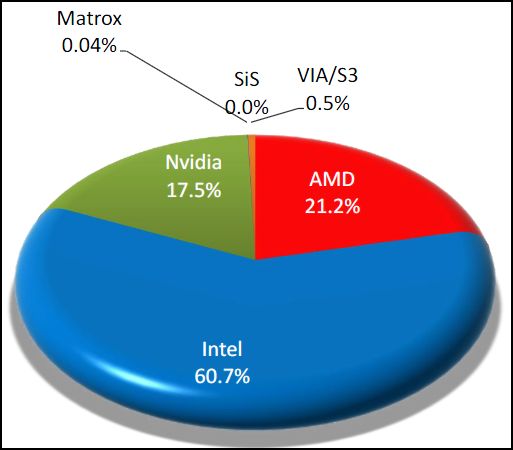It was not a normal second quarter for both graphics chips and PC, with units shipped above normal. AMD and Nvidia are losing market share.
Shipments of graphics chips and components in the second quarter of 2011 did not behave according to past years with regard to seasonality, coming in higher on a year-to-year comparison. 2011 is shaping up to be an anomalous year as businesses take their own path to recovery. Intel’s embedded graphics strategy is starting to shake up the marketplace.

Normally, the second quarter of the year is a slower business quarter in the graphics industry (and in the PC industry as a whole). This year the second quarter did not conform to the normal seasonal cycle. Instead, sales were up significantly compared to previous years and previous quarters. The growth in 2Q comes as a welcome change, if not a bit worrying—is it inventory building for back to school and the holiday season, or channel stuffing?
The Jon Peddie Research forecast for the coming years has been modified since the last report, and is less aggressive on both desktops and notebooks—tablets have changed the nature of the PC market. Our findings include Desktops, Notebooks (and Netbooks), and PC-based commercial (i.e., POS) and industrial/scientific and embedded; and do not include handhelds (i.e., mobile phones), x86 Servers or ARM-based Tablets (i.e. iPad and Android-based Tablets), Smartbooks, or Servers.
The quarter in general:
- In 2Q11 Intel celebrated its sixth quarter of Embedded Processor Graphics CPU shipments (EPG, a multi-chip design that combined a graphics processor and CPU in the same package), and enjoyed a 21% average growth in Desktops and Notebooks.
- AMD and Nvidia lost in overall market share, while Intel grew compared to last quarter.
- Year-to-year this quarter Intel had tremendous market share growth (14.7%), AMD had a loss of 14.2%, and Nvidia slipped 18.4% in the overall market partially due to the company withdrawing from the integrated segments.
- Sequentially, total shipments were up 6.3% from last quarter, significantly above the ten-year average of 3.5%. This raises concerns about inventory buildup.
- Netbooks contributed to notebook growth a bit,however, iPads and Android tablets have probably cannibalized some netbook sales.
- Over 84 million PCs shipped worldwide in 2Q11, an increase of 2.4% compared to 1Q11, (based on an average of reports from Dataquest, IDC, and HSI) causing speculation that the 6.3% up-swing in graphics could be an inventory buildup and have a negative impact on 3Q or 4Q.
- AMD’s HPU quarter-to-quarter growth has been extraordinary, at an average of 80% for desktop and notebook, and Intel’s EPG growth was significant at an average of 41%. This is a clear showing of the industry’s affirmation of the value of CPUs with embedded graphics and is in line with our forecasts. The major, and logical, impact is on older IGPs, and some on low-end add-in boards (AIBS).
Graphics chips (GPUs) and chips with graphics (IGPs, HPUs, and EPGs) are a leading indicator for the PC market. At least one and often two GPUs are present in every PC shipped. It can take the form of a discrete chip, a GPU integrated in the chipset, or embedded in the CPU. The average has grown from 115% in 2001 to almost 160% GPUs per PC.
Since the crash of 2009, combined with the introduction and influence of ARM-based Tablets, the PC market has deviated from historical trends. Until the segment for Tablets is clearly defined the fluctuations in the market data is likely to continue. The disruptions probably won’t settle down for a while as Tablets find their place in the market and agreement can be reached on to include them in the PC market analysis, or to not include them.
Market shares shifted for the big three, and put pressure on the smaller three, as indicated in the accompanying pie chart.
Intel continues to be the overall market share leader in Q2’11, elevated by Core i5 EPG CPUs, Sandy Bridge, and Pineview Atom sales for Netbooks. AMD gained market share quarter-to quarter and Nvidia lost share. Nvidia is exiting the integrated graphics segments and shifting focus to discrete GPUs. The company showed significant discrete market share gain (30% qtr-qtr) due, they say, to strong connect with new Intel Sandybridge notebooks. Ironically Nvidia enjoyed some serendipitous sales of IGPs in 2Q. AMD share dropped 7.3 points.
The quarterly Market Watch Report from Jon Peddie Research gives market share (in units) of all suppliers of graphics chips, integrated, embedded, and discrete worldwide. It is a sell-in report and a leading indicator of computer industry trends. Historical data is included from 1Q04 onward. Market Watch is supplied in electronic form, and includes a written summary of the quarter and an in-depth spreadsheet. For more information: http://jonpeddie.com/publications/market_watch/





